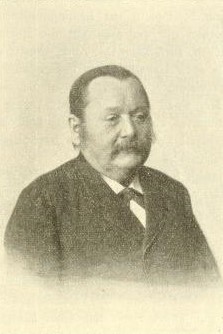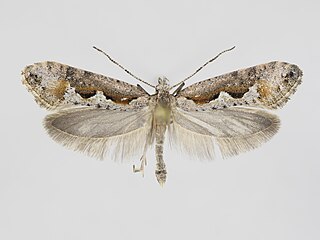Ernst Gottlieb von Steudel was a German physician and an authority on grasses.
Christian Friedrich Ecklon was a Danish botanical collector and apothecary. Ecklon is especially known for being an avid collector and researcher of plants in South Africa.
A polysulfane is a chemical compound of formula H2Sn, where n > 1. Compounds containing 2 – 8 sulfur atoms have been isolated, longer chain compounds have been detected, but only in solution. H2S2 is colourless, higher members are yellow with the colour increasing with the sulfur content. In the chemical literature the term polysulfanes is sometimes used for compounds containing −(S)n−, e.g. organic polysulfanes R1−(S)n−R2.

The element sulfur exists as many allotropes. In number of allotropes, sulfur is second only to carbon. In addition to the allotropes, each allotrope often exists in polymorphs delineated by Greek prefixes.

PHD finger protein 20 is a protein that in humans is encoded by the PHF20 gene.
Christian Ferdinand Friedrich Hochstetter was a German botanist and Protestant minister.

Helga Heinrich-Steudel is a former motorcyclist and car racer of the DDR. She is the only female motorcyclist to have won at the Sachsenring. She ended her career in 1967 but made a comeback in 1970 with her Melkus RS 1000 at the Lückendorfer Bergrennen.
Unio Itineraria was a German scientific society which was based at Esslingen am Neckar in Baden-Württemberg, Germany. The organisation paid botanists to travel and collect plants, and sold the collections in large sets which often resemble exsiccatae. The fourteen series with the title Unio itineraria are listed and described with bibliographic data in IndExs – Index of Exsiccatae. Rising costs associated with the Wilhelm Schimper expeditions led to the collapse of Unio Itineraria in 1842. Significant portions of the Unio Itineraria collections were directed to Herbarium Tubingense at the University of Tübingen in Baden-Württemberg

Trisulfane is the inorganic compound with the formula H2S3. It is a pale yellow volatile liquid with a camphor-like odor. It decomposes readily to hydrogen sulfide and elemental sulfur. It is produced by distillation of the polysulfane oil obtained by acidification of polysulfide salts.

Rhigognostis senilella, the rock-cress smudge, is a moth of the family Plutellidae. It is found in Iceland, Ireland, Great Britain, France, Germany, Denmark, Austria, Switzerland, Italy, the Czech Republic, Slovakia, Serbia, Hungary, Poland, Norway, Sweden, Finland, Latvia, Russia and on Sardinia. Outside of Europe, the range extends to the Caucasus, Central Asia and Japan. It is also found on Greenland. The habitat consists of rocky areas such as coastal or mountain areas.
Plantae preissianae sive enumeratio plantarum quas in australasia occidentali et meridionali-occidentali annis 1838-1841 collegit Ludovicus Preiss, more commonly known as Plantae preissianae, is a book written by Johann Georg Christian Lehmann and Ludwig Preiss.

Wilhelm Steudel was a German physician, ornithologist and entomologist who specialised in Lepidoptera. He described the moth Rhigognostis incarnatella(Steudel, 1873) as Eine neue Plutella – Entomologische Zeitung Stettin 34: 340 - 342. His other papers were published in Jahreshefte des Vereins für vaterländische Naturkunde in Württemberg. Steudel was a member of the Entomological Society of Stettin. His collection of Palearctic microlepidoptera is curated by the State Museum of Natural History Stuttgart.
Rhigognostis hufnagelii is a moth belonging to the family Plutellidae. The species was first described by Philipp Christoph Zeller in 1839.

Ralf Steudel was a German chemist and university professor who was known for his research in the area of sulfur chemistry as well as for his textbook Chemistry of the Non-Metals, which appeared in several languages and many editions. Complementing his pioneering contributions to polysulfides, he authored many reviews on the subject.

Rhigognostis kuusamoensis is a species of moth belonging to the family Plutellidae.
Rhigognostis is a genus of butterfly belonging to the family Plutellidae.
Rhigognostis kovacsi is a species of moth belonging to the family Plutellidae.

Hibbertia ovata is a species of flowering plant in the family Dilleniaceae and is endemic to Western Australia. It is an ascending or erect, spreading shrub that typically grows to a height of 10–60 cm (3.9–23.6 in). It flowers from July to November and has yellow flowers. It was first formally described in 1845 by Ernst Gottlieb von Steudel in Lehmann's Plantae Preissianae. The specific epithet (ovata) means "wider below the middle", referring to the leaves.

Thomasia cognata is a species of flowering plant in the family Malvaceae and is endemic to the south-west of Western Australia. It is a compact, multi-stemmed shrub with wrinkled, narrowly oblong to elliptic leaves and pale pink flowers.










